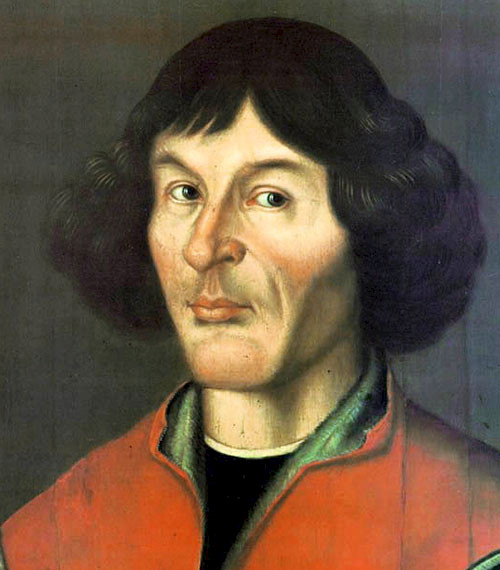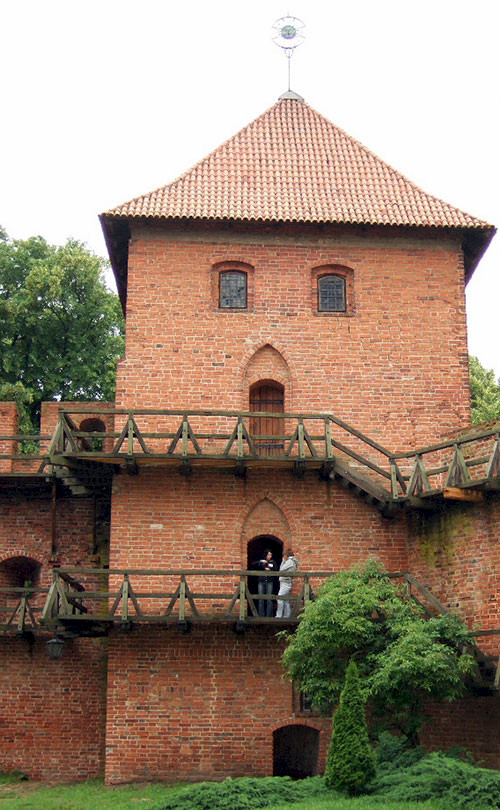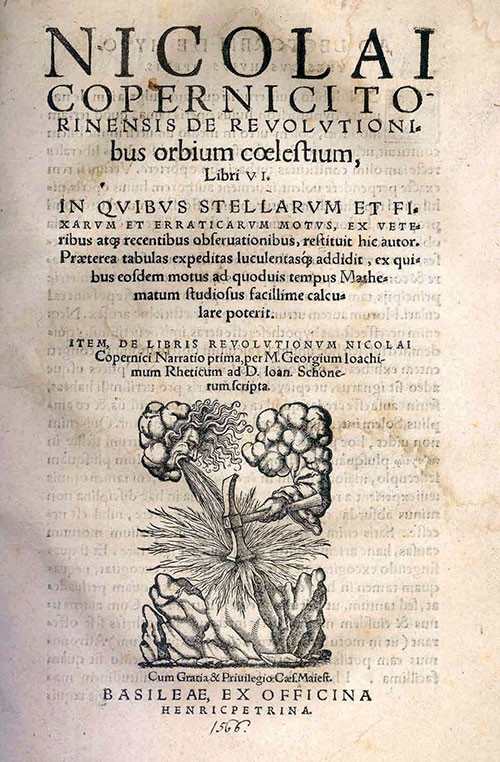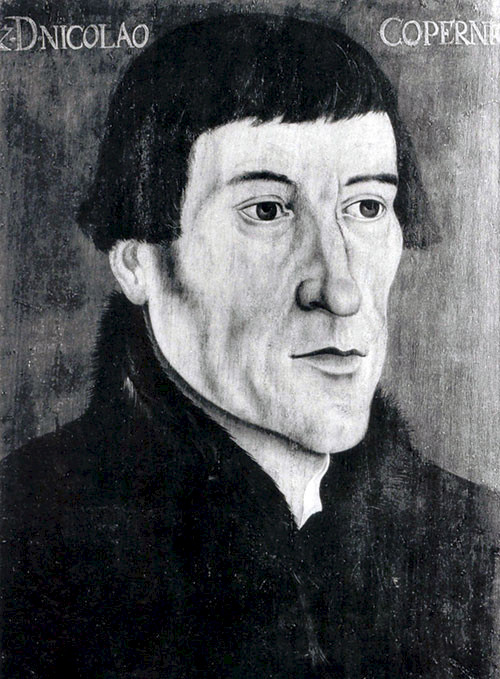Nicholas Copernicus and the Copernican Revolution
Bill Dennison ·'Scientists Who Made a Difference' series
Nicholas Copernicus was an interesting renaissance man who overcame the existing paradigm placing earth in the center of the solar system to the new paradigm of a heliocentric view that earth and the planets revolved around the sun. This perspective led to the Copernican revolution which occurred after Copernicus died in 1543 and published his book, De revolutionibus orbium coelestium (On the Revolutions of the Celestial Spheres).
Nicholas Copernicus was the fourth child of a wealthy copper merchant, born in 1473 in Toruń, Poland on the Vistula River. Copernicus' parents died when he was relatively young; his father died when he was ten and his mother died when he was in his early twenties. Fortunately, his maternal uncle looked after him and he and his older brother Andrew were sent to the University of Krakow (now Jagiellonian University) in the capital of the Kingdom of Poland, Kraków. His four years of education at the University of Krakow exposed Copernicus to astronomy and mathematics.

Copernicus was next sent to the oldest university in the world, University of Bologna in Italy, and he enrolled in 1497. There were no trains, planes or automobiles to travel from northern Poland to Italy, so Copernicus crossed the Alps by foot and by horseback. Nicholas studied law in the University of Bologna, but he became a pupil of an astronomer, Domenico Maria Novara da Ferrera. Copernicus observed the occultation (moon shadow blocking a star) of the star Aldebaron, which encouraged him to develop a model for planetary motion that was consistent with this observation.
In 1500, Copernicus traveled to Rome to celebrate the Christian Jubilee where he gave a series of public lectures on astronomy. He also was able to observe a lunar eclipse while in Rome. Copernicus traveled back to Poland to assume his duties as a church official, but was able to wrangle an extension of his leave to return to Italy for more education. This time Copernicus went to the University of Padua to study medicine. Copernicus also traveled to nearby Ferrera where he passed exams for his Doctor of Canon Law (PhD equivalent). When he returned to Poland in 1503 to spend the rest of his life, he was a very well educated, unmarried 30 year old man.
When Copernicus was beginning his career, Christopher Columbus had 'discovered' the new world in 1492 and Vasco da Gama had found a route to India in 1497. Magellan set off for the circumnavigation of the globe in 1519. Martin Luther was developing a alternative to the Roman Catholic Church. The region of northern Poland where Copernicus spent most of his life was being contested between the Teutonic Order and the Kingdom of Poland. The largest city in the world was Constantinople, capital of the Ottoman Empire. Most people lived in small villages and the church was the major structure and gathering place.
In this setting, Copernicus began a career with a variety of duties as a church official, which included administering medicine, reforming the monetary system, settling legal disputes, providing defense against Teutonic invaders. In order to assume these duties, procured by his uncle, Copernicus was required to take a vow of celibacy, thus he never married. However, he was chastised for having a relationship with his housekeeper Anna Schilling and although he did not have children, he assumed guardianship for his five nieces and nephews after his sister died.
In spite of variable weather conditions, extensive local travel associated with his church duties, ransacking by Teutonic Knights, and primitive equipment (the telescope had not been invented), Copernicus was able to continue his celestial observations using an observatory that he constructed. He was primarily based in Frombork, a town on Vistula Lagoon off the Baltic Sea. Shortly after arriving back in Poland, he produced a 40 pp. manuscript entitled Commentariolus in which he outlined seven assumptions or principles of a heliocentric system (not unlike the environmental literacy principles outlined in a previous blog).

The seven assumptions outlined by Copernicus were the following:
- There is no one center of all the celestial circles or spheres.
- The center of the earth is not the center of the universe, but only of gravity and of the lunar sphere.
- All the spheres revolve about the sun as their mid-point, and therefore the sun is the center of the universe.
- The ratio of the earth's distance from the sun to the height of the firmament (outermost celestial sphere containing the stars) is so much smaller than the ratio of the earth's radius to its distance from the sun that the distance from the earth to the sun is imperceptible in comparison with the height of the firmament.
- Whatever motion appears in the firmament arises not from any motion of the firmament, but from the earth's motion. The earth together with its circumjacent elements performs a complete rotation on its fixed poles in a daily motion, while the firmament and highest heaven abide unchanged.
- What appear to us as motions of the sun arise not from its motion but from the motion of the earth and our sphere, with which we revolve about the sun like any other planet. The earth has, then, more than one motion.
- The apparent retrograde and direct motion of the planets arises not from their motion but from the earth's. The motion of the earth alone, therefore, suffices to explain so many apparent inequalities in the heavens.
By 1532, Copernicus had expounded on these assumptions and completed his book De revolutionibus orbium coelestium, but despite encouragement by his friends, refused to publish. He was fearful of the repercussions that his book would cause. But with the help and encouragement by his German pupil Georg Rheticus, he finally relented and the book was sent to a printer in 1543. A Lutheran theologian added an unauthorized preface and Copernicus dedicated the book to the Pope, both designed to mute the impact of this revolutionary work on the establishment represented by the church.

Copernicus received a copy of De revolutionibus orbium coelestium on his deathbed in 1543. He was buried in the Frombork Cathedral, and as a footnote, his body was recently exhumed and DNA analysis conducted to confirm it was indeed Copernicus. He was reburied with a second funeral in 2010.
The publication of De revolutionibus orbium coelestium did not cause an immediate stir, but it did have a profound impact. It was not until decades later, especially when Galielo Galilei espoused the Copernican doctrine, that the heliocentric theory became controversial with church doctrine. Meanwhile, such things were written about Coperncius as "certain people believe it is a marvelous achievement to extol so crazy a thing, like that Polish astronomer who makes the earth move and the sun stand still. Really, wise governments ought to repress impudence of mind." And in 1616, the Catholic Church issued a decree suspending De revolutionibus, which wasn't lifted until 1835.

There are many plaques and statues honoring Copernicus, particularly in Poland and Italy. The University of Copernicus, founded in 1945, is in Toruń, Poland. Thomas Kuhn published a book entitled "The Copernican Revolution" in 1957 in which he uses the Copernicus case study to establish a theory of scientific advancement through a series of paradigm shifts. The chemical element Copernicum (Cn: atomic number 112) was named in honor of Copernicus in 2010.
About the author
Bill Dennison

Dr. Bill Dennison is a Professor of Marine Science and Vice President for Science Application at the University of Maryland Center for Environmental Science.
Next Post > Moreton Bay, Australia: Environmental Literacy
Comments
-
Mary O'Neil 12 years ago
Martin Luther's memorable comment on Copernicus: "an upstart astrologer who wants to overturn the entire system of astronomy." Luther and the Reformation were into Scripture and Joshua had made the "sun stand still," so that was that for Luther. Copernicus had the good sense to die in 1543, the same year his difficult Latin mathematical treatise was published; few people could understand it until Galileo's popularizing 1632. So Galileo was the first person persecuted by the Catholic Church for Copernican ideas.
-
Delena Bobadilla 9 years ago
Invaluable discussion . I was fascinated by the info ! Does someone know where I can get access to a template a form version to use ?